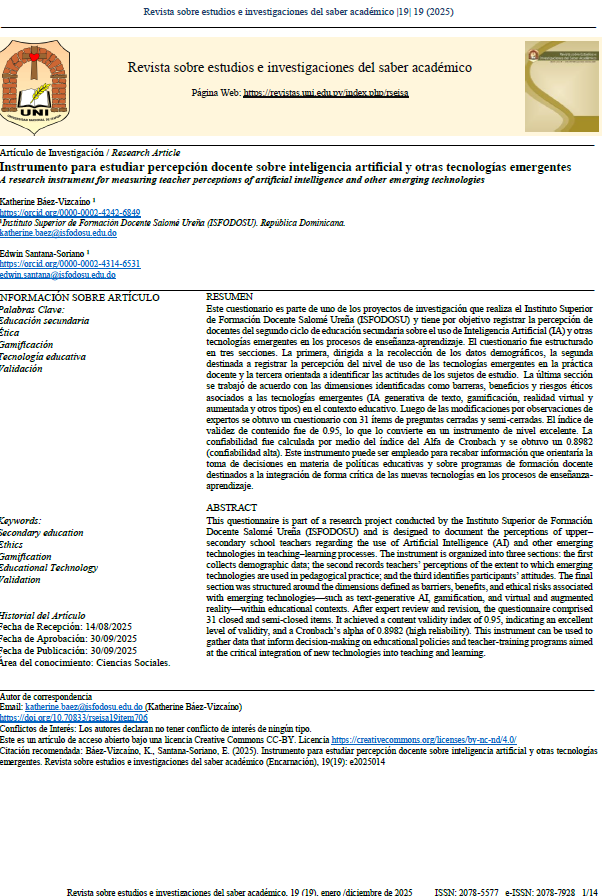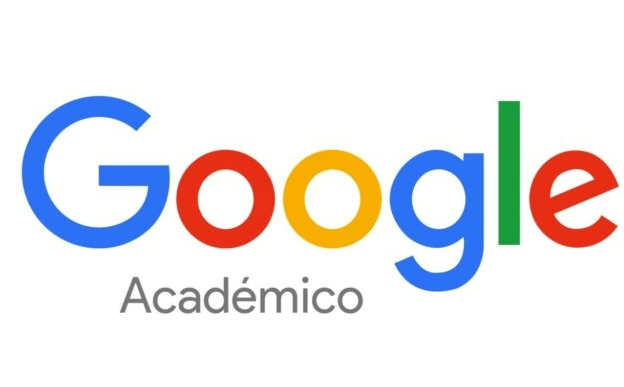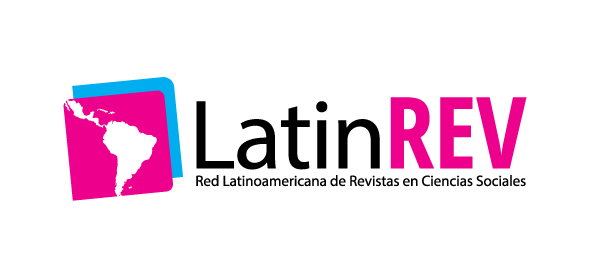A research instrument for measuring teacher perceptions of artificial intelligence and other emerging technologies
DOI:
https://doi.org/10.70833/rseisa19item706Keywords:
Secundary Education, Ethics, Gamification, Educational Technology, ValidationAbstract
This questionnaire is part of a research project conducted by the Instituto Superior de Formación Docente Salomé Ureña (ISFODOSU) and is designed to document the perceptions of upper–secondary school teachers regarding the use of Artificial Intelligence (AI) and other emerging technologies in teaching–learning processes. The instrument is organized into three sections: the first collects demographic data; the second records teachers’ perceptions of the extent to which emerging technologies are used in pedagogical practice; and the third identifies participants’ attitudes. The final section was structured around the dimensions defined as barriers, benefits, and ethical risks associated with emerging technologies—such as text-generative AI, gamification, and virtual and augmented reality—within educational contexts. After expert review and revision, the questionnaire comprised 31 closed and semi-closed items. It achieved a content validity index of 0.95, indicating an excellent level of validity, and a Cronbach’s alpha of 0.8982 (high reliability). This instrument can be used to gather data that inform decision-making on educational policies and teacher-training programs aimed at the critical integration of new technologies into teaching and learning.
Downloads
References
Aboalshamat, Khalid (2022). Perception and utilization of artificial intelligence (AI) among dental professionals in Saudi Arabia. The Open Dentistry Journal, 16. http://dx.doi.org/10.2174/18742106-v16-e2208110
Althubyani, A. R. (2024). Digital Competence of Teachers and the Factors Affecting Their Competence Level: A Nationwide Mixed-Methods Study. Sustainability, 16(7), 2796. https://doi.org/10.3390/su16072796
Almerich, G., Suárez, J. M., Belloch, C., & Orellana, N. (2010). Perfiles del profesorado a partir del conocimiento de los recursos tecnológicos y su relación con el uso que hacen de estas tecnologías. Revista Complutense de Educación, 21(2), 247–269. https://revistas.ucm.es/index.php/RCED/article/view/RCED1010220247A/15070
Assinnato, G., Sanz, C., Gorga, G., & Martín, M. V. (2018). Actitudes y percepciones de docentes y estudiantes en relación a las TIC: Revisión de la literatura. Revista Iberoamericana de Tecnología en Educación y Educación en Tecnología, (22), 7–17. https://doi.org/10.24215/18509959.22.e01
Badia, A., Chumpitaz Campos, L., Vargas D'Uniam, J., & Suárez Díaz, G. (2016). La percepción de la utilidad de la tecnología conforma su uso para enseñar y aprender. Revista Electrónica de Investigación Educativa, 18(3), 95–105. http://redie.uabc.mx/redie/article/view/810
Batanero, J. M., & Bermejo, B. (2012). Actitudes docentes hacia las TIC en centros de buenas prácticas educativas con orientación educativa. Enseñanza & Teaching, 30(1), 45–61. https://revistas.usal.es/tres/index.php/0212-5374/article/view/9296
Castillo Díaz, M., Larios Rosillo, V. M., & García Ponce de León, O. (2010). Percepción de los docentes de la utilización de las Tecnologías de la Información y la Comunicación. Revista Iberoamericana de Educación, 53(6). https://rieoei.org/historico/deloslectores/3375Castillo.pdf
Cajas Bravo, T. V., Silva Infantes, M., & Dávila Morán, R. C. (2023). Percepción docente sobre el uso de la tecnología en la educación superior. Conrado, 19(90), 326–335.
Chyung, S. Y., Roberts, K., Swanson, I., & Hankinson, A. (2017). Evidence-based survey design: The use of a midpoint on the Likert scale. Performance Improvement, 56(10), 15–23. https://doi.org/10.1002/pfi.21727
EDUCAUSE. (2023). 2023 EDUCAUSE Horizon Report: Teaching and Learning Edition. EDUCAUSE. https://library.educause.edu/resources/2023/5/2023-educause-horizon-report-teaching-and-learning-edition
ElSayary, A. (2024). An investigation of teachers' perceptions of using ChatGPT as a supporting tool for teaching and learning in the digital era. Journal of Computer Assisted Learning, 40(3), 931–945. https://doi.org/10.1111/jcal.12926
Gil-Flores, J., Rodríguez-Santero, J., & Torres-Gordillo, J. J. (2017). Factors that explain the use of ICT in secondary-education classrooms: The role of teacher characteristics and school infrastructure. Computers in Human Behavior, 68, 441-449. https://doi.org/10.1016/j.chb.2016.11.057
Hernández-Nieto, R. A. (2011). Instrumentos de recolección de datos en ciencias sociales y ciencias biomédicas. Universidad de Los Andes.
Hill, S. J., & Roberts, M. E. (2023). Acquiescence bias inflates estimates of conspiratorial beliefs and political misperceptions. Political Analysis, 31(4), 575–590. https://doi.org/10.1017/pan.2022.28
Ibrahim, U. (2024). Integration of emerging technologies in teacher education for global competitiveness. International Journal of Educational and Life Sciences, 2(2), 127–138. https://doi.org/10.59890/ijels.v2i2.1334
Joshi, A., Kale, S., Chandel, S., & Pal, D. K. (2015). Likert scale: Explored and explained. British Journal of Applied Science & Technology, 7(4), 396–403. https://doi.org/10.9734/BJAST/2015/14975
Kusmaryono, I., Wijayanti, D., & Maharani, H. R. (2022). Number of response options, reliability, validity, and potential bias in the use of the Likert scale education and social science research: A literature review. International Journal of Educational Methodology, 8(4), 625–637. https://doi.org/10.12973/ijem.8.4.625
Lee, D., Arnold, M., Srivastava, A., Plastow, K., Strelan, P., Ploeckl, F., Lekkas, D., & Palmer, E. (2024). The impact of generative AI on higher education learning and teaching: A study of educators’ perspectives. Computers and Education: Artificial Intelligence, 6, 100221. https://doi.org/10.1016/j.caeai.2024.100221
Mariaca Garron, M. C., Zagalaz Sánchez, M. L., Campoy Aranda, T. J., & González González de Mesa, C. (2022). Revisión bibliográfica sobre el uso de las TIC en la educación. Revista Internacional de Investigación en Ciencias Sociales, 18(1), 23–40. https://doi.org/10.18004/riics.2022.junio.23
Martínez-Serrano, M. C. (2019). Percepción de la integración y uso de las Tecnologías de la Información y la Comunicación (TIC). Estudio de profesores y estudiantes de educación primaria. Información Tecnológica, 30(1), 237–246. https://doi.org/10.4067/S0718-07642019000100237
Miralles Martínez, P., Gómez Carrasco, C. J., & Monteagudo Fernández, J. (2019). Percepciones sobre el uso de recursos TIC y mass media para la enseñanza de la historia: Un estudio comparativo en futuros docentes de España e Inglaterra. Educación XX1, 22(2), 187–211. https://doi.org/10.5944/educxx1.21377
Pegalajar Palomino, M. D., (2015). Diseño y validación de un cuestionario sobre percepciones de futuros docentes hacia las tic para el desarrollo de prácticas inclusivas. Pixel-Bit. Revista de Medios y Educación, (47), 89-104.
Prestridge, S. (2012). The beliefs behind the teacher that influences their ICT practices. Computers & Education, 58, 449–458.
Santana-Soriano, E. (2023). Ética y filosofía de la inteligencia artificial: Debates actuales. La Barca de Teseo, 1(1), 47–64. https://doi.org/10.61780/bdet.v1i1.5
Santana-Soriano, E. (2025). Ética e inteligencia artificial en educación: un análisis bibliométrico de tendencias emergentes y desafíos. Ciencia y Educación, 9(1), 1-17. https://doi.org/10.222067cyed.2025.v9i1.3255
Santana-Soriano, E. y Baez-Vizcaino, K. (2025). Inteligencia artificial, gamificación y realidad virtual en la educación secundaria dominicana: un análisis descriptivo. Edutec, Revista Electrónica de Tecnología Educativa, (92), 196-215. https://doi.org/10.21556/edutec.2025.92.3833
Tejedor, F. J., García-Valcárcel, A., & Prada, S. (2009). Medida de actitudes del profesorado universitario hacia la integración de las TIC. Comunicar, 33, 115–124. https://doi.org/10.3916/c33-2009-03-002
Thoring, A., Rudolph, D., & Vogl, R. (2018). The digital transformation of teaching in higher education from an academic’s point of view: An explorative study. In P. Zaphiris & A. Ioannou (Eds.), Learning and collaboration technologies: Design, development and technological innovation (Lecture Notes in Computer Science, Vol. 10924, pp. 400–415). Springer. https://doi.org/10.1007/978-3-319-91743-6_23
UNESCO International Bureau of Education. (2021). The platformization of education: A framework to map the new directions of hybrid education systems (Current and Critical Issues in Curriculum, Learning and Assessment, 46). UNESCO. https://unesdoc.unesco.org/ark:/48223/pf0000377733
Vega-Gea, E., Calmaestra, J., & Ortega-Ruiz, R. (2021). Percepción docente del uso de las TIC en la Educación Inclusiva. Pixel-Bit. Revista de Medios y Educación, 62, 235-268. https://doi.org/10.12795/pixelbit.90323
Weijters, B., Geuens, M., & Schillewaert, N. (2010). The individual consistency of acquiescence and extreme response style in self-report questionnaires. Applied Psychological Measurement, 34(2), 105–121. https://doi.org/10.1177/0146621609338593

Published
How to Cite
License
Copyright (c) 2025 Katherine Báez-Vizcaíno , Edwin Santana-Soriano

This work is licensed under a Creative Commons Attribution 4.0 International License.
Creative Commons Attribution License CC-BY
You are free to:
Share — copy and redistribute the material in any medium or format.
Adapt — remix, transform, and build upon the material for any purpose, including commercially.
Under the following terms:
Attribution — You must give appropriate credit, provide a link to the license, and indicate if any changes have been made. You may do so in any reasonable way, but not in any way that suggests that you or your use is endorsed by the Licensor.






